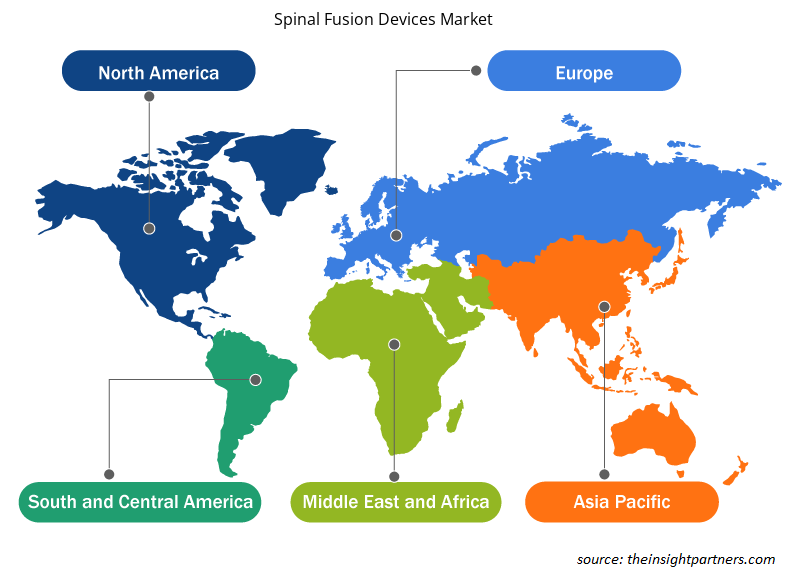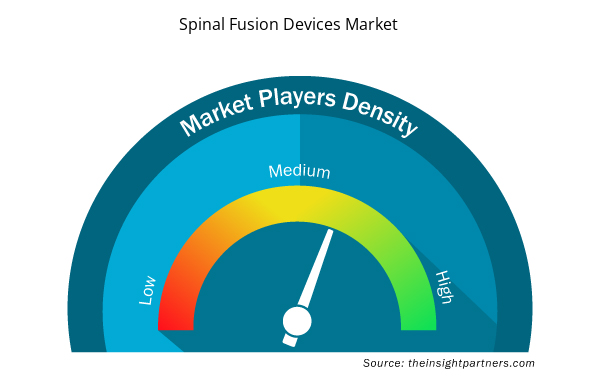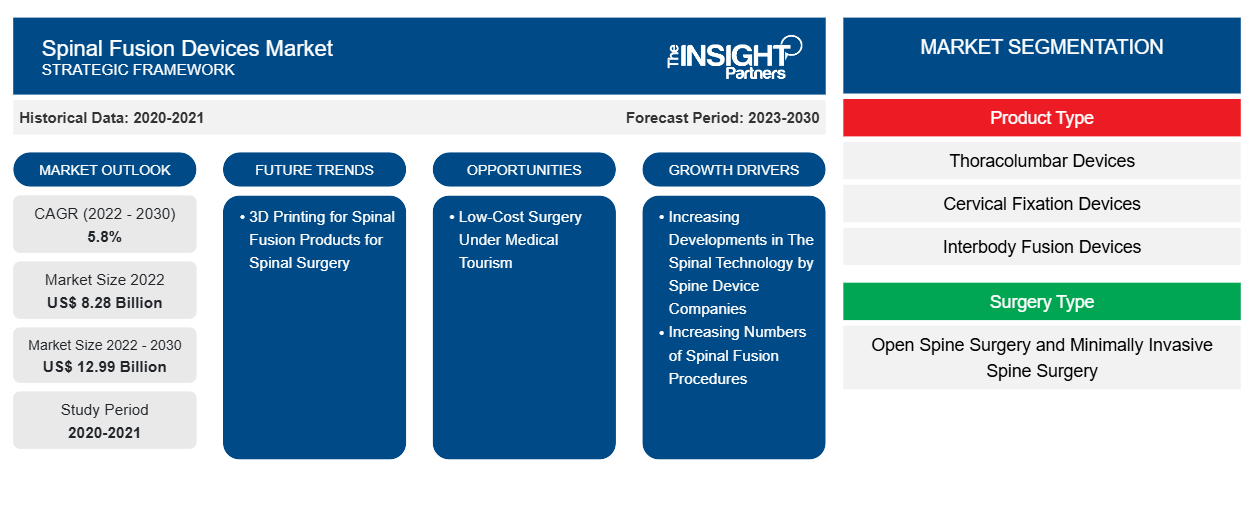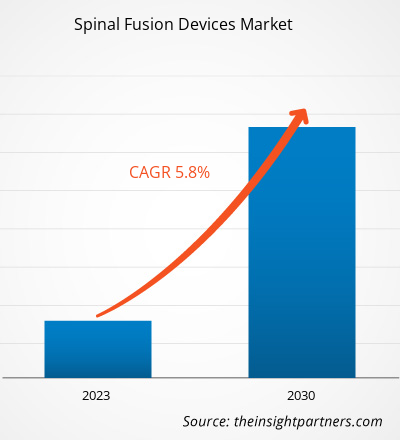[研究报告] 脊柱融合装置市场规模预计将从 2022 年的 82.7631 亿美元增长到 2030 年的 129.9325 亿美元,预计 2022 年至 2030 年的复合年增长率为 5.8%。
市场洞察和分析师观点:
由于胆结石病例增加导致脊柱融合器病例增加,脊柱融合器市场规模正在迅速增长。此外,糖尿病病例的增加也推动了市场的 增长。
此外,公司为市场开发而采取的战略举措也推动了市场的增长。2022 年 9 月,GE Healthcare 宣布其突破性的 AIR Recon DL 获得美国 FDA 510(k) 批准,可用于 3D 和 PROPELLER 成像序列。这些新功能将 AIR Recon DL 的优势扩展到几乎所有磁共振成像 (MRI) 临床程序,涵盖所有解剖结构,并实现更好的图像质量、更短的扫描时间和增强的患者体验。因此,在预测期内,革命性技术的显着增长可能会为市场带来新的趋势,以满足客户需求。
机遇与挑战:
脊柱融合手术的费用要高得多;许多患者在决定接受脊柱手术时打退堂鼓。此外,在许多情况下,脊柱植入物的费用不在医疗保险计划的承保范围内,从而限制了手术的数量。例如,像美国这样的国家很昂贵;根据 2022 年 2 月发布的《医疗蓝皮书》数据,腰椎融合手术费用排名前 5 位的城市如下:丹佛:86,182 美元,加利福尼亚州圣何塞:78,809 美元旧金山:78,809 美元,印第安纳波利斯:77,269 美元,西雅图:74,499 美元。同时,在田纳西州孟菲斯和圣安东尼奥等城市,腰椎融合手术的费用最低约为 48,000 美元。
定制此报告以满足您的需求
您可以免费定制任何报告,包括本报告的部分内容、国家级分析、Excel 数据包,以及为初创企业和大学提供优惠和折扣
- 获取此报告的关键市场趋势。这个免费样品将包括数据分析,从市场趋势到估计和预测。
另一方面,医疗旅游使得脊柱融合手术的成本更低。发展中地区的国家已经大力发展医疗旅游业,并拥有先进的技术,可以以更低的价格提供世界一流的医疗服务。Lyfboat Technologies Pvt. 于 2023 年 7 月发布的数据显示,印度、泰国、土耳其、阿联酋和埃及等国家被认为最适合提供 8,000 美元至 16,000 美元之间的脊柱侧弯手术。Lyfboat Technologies Pvt 发布的数据还显示,埃及的脊柱融合手术费用为 10,897 美元,阿联酋的费用约为 8,200 美元。同样,在土耳其,脊柱融合手术的费用为 15,000 美元,在印度的费用约为 8000 美元至 12,000 美元。此外,印度的胸廓成形术费用在 2,500 美元至 4,000 美元之间。
以较低成本提供重大手术可增加患者前往这些国家接受治疗的流量。此外,先进医疗技术的可用性和政府为增加医疗旅游业而增加的资金正在导致对先进外科植入物的需求不断增加。此外,发展中国家先进的医疗保健基础设施可能会继续推动对先进医疗设备的需求,从而增强脊柱融合设备市场的增长机会。
脊柱融合装置的监管要求与其他可植入装置不同。脊柱融合装置的法规定期更新,以保持产品质量,为患者提供更高质量的生活。2023 年 3 月,美国食品药品监督管理局 (FDA) 更新了医疗器械、矫形器械、用于椎间融合手术的脊柱球体分类(最终规则)最终监管影响分析。根据 FDA 的分析,脊柱装置被归类为 III 类。这些设备将需要单独提交上市前批准申请。此外,FDA 发现一般和特殊控制不足以确保设备的有效性和安全性。因此,预计公司必须提供完整的产品描述和产品效率和安全性分析,以避免对产品材料和规格与临床状况的尺寸和意图产生混淆。
同样,发展中国家的法规也在更新脊柱融合器械的监管要求。2021年11月,澳大利亚政府卫生和老年护理部治疗用品管理局(TGA)修订了脊柱植入式医疗器械的监管框架。TGA旨在通过新的监管要求支持赞助商和制造商了解和遵守更新后的要求。TGA对制造商提出了四项主要要求,包括需要在ARTG条目中提供有关IIb类脊柱融合器械的具体信息;TGA对器械纳入申请的强制性审计评估,包括临床证据评估;证明器械分类适当程序的合格评定文件,以及制造商对与每种器械相关的质量管理体系和技术文档的详尽评估。因此,对制造商的法规严格将导致更多的经济投资,而召回风险可能会导致损失。因此,脊柱融合器械的严格规定是阻碍市场增长的因素之一。
报告细分和范围:
脊柱融合器械市场份额根据产品类型、手术类型、疾病适应症和最终用户进行划分。脊柱融合器械市场按产品类型细分为胸腰椎器械、颈椎固定器械和椎间融合器械。脊柱融合器械市场按手术类型分为开放式脊柱手术和微创脊柱手术。脊柱融合器械市场按疾病适应症划分,分为退化椎间盘,创伤和骨折,复杂畸形等。脊柱融合设备市场按最终用户细分为医院、专科诊所等。根据地域,市场分为北美(美国、加拿大和墨西哥)、欧洲(英国、德国、法国、意大利、西班牙和欧洲其他地区)、亚太地区(中国、日本、印度、韩国、澳大利亚和亚太其他地区)、中东和非洲(阿联酋、沙特阿拉伯、南非和中东和非洲其他地区)以及南美洲和中美洲(巴西、阿根廷和南美洲和中美洲其他地区)。
节段分析:
根据手术类型,脊柱融合装置市场分为开放式脊柱手术和微创脊柱手术。2022 年,开放式脊柱手术部分在手术市场中占有较大的份额。由于越来越多地采用微创脊柱手术方法,微创脊柱手术部分预计在 2022-2030 年期间以更高的复合年增长率增长。开放式手术被视为标准手术,因为它们可以完全暴露解剖结构。建议使用开放式脊柱手术来治疗脊柱侧弯、椎间盘严重退化、脊柱不稳定或这些问题的组合等疾病。如果病情严重且复杂,则广泛首选开放式手术;它提供了更大的解剖结构暴露,使手术更容易,并且周围结构的可见性更高。但是,开放式脊柱手术类型存在多种风险。风险包括失血过多和恢复时间更长。
在许多情况下,开放式脊柱手术可能会逆转脊柱疾病的症状。并发症还可能导致感染、伤口愈合不良、血栓以及周围静脉或神经受损。
微创脊柱手术类型 (MISS) 比传统的开放式脊柱手术类型更受关注。MISS 需要较小的切口;因此,说服患者接受 MISS 更容易。其他优势,例如避免损伤周围肌肉、出血更少、疼痛更少、恢复更快和住院时间更短,增加了 MISS 的采用率。目前,MISS 被认为是脊柱融合的常见手术。MISS 的更高采用率包括通过限制风险和改变报销模式和患者偏好来治疗老年人和重病患者的脊柱问题。此外,MISS 的转变通过结合强大的软件引入了新的术中成像技术。成像技术和软件的结合允许外科医生进行实时导航,以补充他们对脊柱三维 (3D) 解剖结构的理解。因此,MISS 的转变正在导致该细分市场增长最快,最终推动市场增长。根据 2022 年 7 月发表的一篇题为“微创脊柱手术类型:概述”的文章,美国每年 120 万例脊柱手术中约 75% 采用 MISS 技术进行。同样,2022 年 1 月发表的一篇题为“脊柱内窥镜检查:证据、技术、全球趋势和未来预测”的文章指出,96.7% 的亚洲外科医生实施 MISS。因此,考虑到 MISS 手术数量的增加,预计未来几年市场将显着增长。
按产品类型划分,脊柱融合器械市场可细分为胸腰椎器械、颈椎固定器械和椎间融合器械。2022 年,按产品类型划分,胸腰椎器械细分市场占据了最大的市场份额。由于椎间融合器械的不断发展,椎间融合器械细分市场预计在 2022-2030 年期间将以显着的复合年增长率增长。按疾病适应症划分,脊柱融合器械市场分为退行性椎间盘、创伤和骨折、复杂畸形等。2022 年,按疾病适应症划分,退行性椎间盘细分市场占据了最大的市场份额,并且预计在 2022-2030 年期间将以显着的复合年增长率增长,原因是老年人口的增长更容易患上退行性疾病。按最终用户划分,脊柱融合器械市场分为医院、专科诊所等。 2022 年,医院部门占据了最大的市场份额,预计未来几年将以最快的速度增长。
区域分析:
根据地理位置,脊柱融合设备市场分为北美、欧洲、亚太地区、中东和非洲以及南美和中美洲。北美是市场增长的最大贡献者,亚太地区是增长最快的地区。北美脊柱融合设备市场分为美国、加拿大和墨西哥。2022 年,美国在该地区占有最大的市场份额,预计在预测期内将继续保持主导地位。DePuy Synthes、Stryker、Aurora Spine 和 Alevio Spine 是美国脊柱融合设备市场的主要参与者。这些参与者推动的产品开发和发布有利于市场增长。美国食品药品监督管理局 (FDA) 批准的技术先进的脊柱融合设备在美国被广泛采用。以下是 FDA 最近批准的脊柱融合设备列表:
- 2023 年 5 月,CTL Amedica 获得 FDA 510(k) 批准,可商业化 NITRO 椎间融合笼系统,该系统完全由生物材料氮化硅融合而成。氮化硅材料与所有成像方式兼容;它具有独特的抑菌特性并提供无伪影成像。
- 2023 年 1 月,Alevio Spine 获得 510 (K) 批准,用于 SI-Cure SI 关节融合系统的附加适应症。扩大的适应症包括骶髂融合,适用于骨骼成熟的患者,这些患者在腰椎或胸腰椎融合术中接受骶骨盆固定。
- 2022 年 6 月,美国 FDA 为 Aurora Spine 的 DEXA SOLO-L 前路腰椎椎间融合器 (ALIF) 颁发了 510K 许可。基于 DEXA 技术平台,设计了一种 3D 打印独立设备,用于前路和侧路腰椎椎间融合术 (ALIF & LLIF) 手术。
与年龄相关的磨损引发了美国老年人群下背痛 (LBP) 的流行,进而刺激了对脊柱融合装置的需求。根据 2022 年国家卫生服务局的数据,美国 LBP 的终生发病率为 60-90%,年发病率为 5%。该消息来源还指出,每年有 14.3% 的新患者因 LBP 就诊,约有 1300 万人因慢性 LBP 就诊。
脊柱融合设备市场区域洞察
Insight Partners 的分析师已详尽解释了预测期内影响脊柱融合设备市场的区域趋势和因素。本节还讨论了北美、欧洲、亚太地区、中东和非洲以及南美和中美洲的脊柱融合设备市场细分和地理位置。

- 获取脊柱融合设备市场的区域特定数据
脊柱融合装置市场报告范围
| 报告属性 | 细节 |
|---|---|
| 2022 年市场规模 | 82.8亿美元 |
| 2030 年的市场规模 | 129.9 亿美元 |
| 全球复合年增长率(2022 - 2030 年) | 5.8% |
| 史料 | 2020-2021 |
| 预测期 | 2023-2030 |
| 涵盖的领域 | 按产品类型
|
| 覆盖地区和国家 | 北美
|
| 市场领导者和主要公司简介 |
|
脊柱融合设备市场参与者密度:了解其对业务动态的影响
脊柱融合设备市场正在快速增长,这得益于终端用户需求的不断增长,而这些需求又源于消费者偏好的不断变化、技术进步以及对产品优势的认识不断提高等因素。随着需求的增加,企业正在扩大其产品范围,进行创新以满足消费者的需求,并利用新兴趋势,从而进一步推动市场增长。
市场参与者密度是指在特定市场或行业内运营的企业或公司的分布情况。它表明在给定市场空间中,相对于其规模或总市场价值,有多少竞争对手(市场参与者)存在。
脊柱融合设备市场的主要运营公司有:
- DePuy Synthes 公司
- 史赛克公司
- B. Braun SE
- ATEC Spine 公司
- 格洛布斯医疗公司
免责声明:上面列出的公司没有按照任何特定顺序排列。

- 了解脊柱融合设备市场顶级关键参与者概况
行业发展和未来机遇:
以下列出了脊柱融合设备市场主要参与者的各种举措:
- 2023 年 2 月,著名的肌肉骨骼解决方案提供商 Globus Medical Inc 和脊柱技术创新先驱 NUVASIVE 同意以全股票交易的方式合并。此次交易将两家知名的肌肉骨骼技术公司聚集在一起,共同致力于创新,不懈追求未满足的临床需求,以改善患者护理。
- 2022 年 11 月,Centinel Spine LLC 宣布首次植入其 prodisc C SK 颈椎全椎间盘置换 (TDR) 产品。prodisc C SK 系统是即将发布的三款新产品中的第二款。
- 2022 年 3 月,DePuy Synthes Inc 收购了 CUPTIMIZE 髋关节脊柱分析,为外科医生提供了一种易于使用的工具,以更好地了解和解决某些需要全髋关节置换术 (THA) 的患者脊柱和骨盆之间异常活动的影响。CUPTIMIZE 髋关节脊柱分析提高了 VELYS 髋关节导航的手术规划能力,VELYS 髋关节导航是 DePuy Synthes 的 VELYS 数字手术互联技术平台之一。
竞争格局和重点公司:
脊柱融合设备市场中一些知名企业包括美敦力公司 (Medtronic PLC)、强生服务公司 (Johnson & Johnson Services Inc)、B.Braun SE、史赛克公司 (Stryker Corp)、ATEC Spine Inc、Globus Medical Inc、NuVasive Inc、ZimVie Inc、Centinel Spine LLC 和 Orthofix Medical Inc。这些公司专注于新产品发布和地域扩张,以满足全球日益增长的消费者需求,并增加其专业产品组合中的产品范围。它们的全球业务使它们能够服务于大量客户,从而扩大其市场份额。
- 历史分析(2 年)、基准年、预测(7 年)及复合年增长率
- PEST 和 SWOT 分析
- 市场规模价值/数量 - 全球、区域、国家
- 行业和竞争格局
- Excel 数据集



Report Coverage
Revenue forecast, Company Analysis, Industry landscape, Growth factors, and Trends

Segment Covered
This text is related
to segments covered.

Regional Scope
North America, Europe, Asia Pacific, Middle East & Africa, South & Central America

Country Scope
This text is related
to country scope.
常见问题
Companies operating in the market are Medtronic PLC, Johnson & Johnson Services Inc, B.Braun SE, Stryker Corp, ATEC Spine Inc, Globus Medical Inc, NuVasive Inc, ZimVie Inc, Centinel Spine LLC, and Orthofix Medical Inc.
The spinal fusion devices market, by product type, is bifurcated into thoracolumbar devices, cervical fixation devices, and interbody fusion devices. In 2022, the thoracolumbar devices segment held the largest share of the market by product type. And interbody fusion devices segment is estimated to grow at a significant CAGR during 2022-2030.
The factors driving the market include the increasing developments in the spinal technology by spine device companies and increasing numbers of spinal fusion procedures.
Global spinal fusion devices market is segmented by region into North America, Europe, Asia Pacific, the Middle East & Africa, and South & Central America. North America is likely to continue its dominance in the spinal fusion devices market during 2022–2030. The US holds the largest share of the market in North America and is expected to continue this trend during the forecast period.
The spinal fusion devices market, by surgery type, is bifurcated into open spine surgery and minimally invasive spine surgery. In 2022, the open spine surgery segment held the largest share of the market by surgery. And minimally invasive spine surgery segment is estimated to grow at a significant CAGR during 2022-2030.
Spinal fusion is surgery to connect two or more bones in any part of the spine. Connecting them prevents movement between them. Preventing movement helps to prevent pain. During spinal fusion, a surgeon places bone or a bonelike material in the space between two spinal bones. Metal plates, screws or rods might hold the bones together. They then can fuse and heal as one bone.
Trends and growth analysis reports related to Life Sciences : READ MORE..
The List of Companies - Spinal Fusion Devices Market
- DePuy Synthes Inc.
- Stryker Corp
- B. Braun SE
- ATEC Spine Inc.
- Globus Medical Inc.
- NuVasive Inc.
- ZimVie Inc.
- Medtronic Plc
- Centinel Spine LLC
- Orthofix Medical Inc.
The Insight Partners performs research in 4 major stages: Data Collection & Secondary Research, Primary Research, Data Analysis and Data Triangulation & Final Review.
- Data Collection and Secondary Research:
As a market research and consulting firm operating from a decade, we have published and advised several client across the globe. First step for any study will start with an assessment of currently available data and insights from existing reports. Further, historical and current market information is collected from Investor Presentations, Annual Reports, SEC Filings, etc., and other information related to company’s performance and market positioning are gathered from Paid Databases (Factiva, Hoovers, and Reuters) and various other publications available in public domain.
Several associations trade associates, technical forums, institutes, societies and organization are accessed to gain technical as well as market related insights through their publications such as research papers, blogs and press releases related to the studies are referred to get cues about the market. Further, white papers, journals, magazines, and other news articles published in last 3 years are scrutinized and analyzed to understand the current market trends.
- Primary Research:
The primarily interview analysis comprise of data obtained from industry participants interview and answers to survey questions gathered by in-house primary team.
For primary research, interviews are conducted with industry experts/CEOs/Marketing Managers/VPs/Subject Matter Experts from both demand and supply side to get a 360-degree view of the market. The primary team conducts several interviews based on the complexity of the markets to understand the various market trends and dynamics which makes research more credible and precise.
A typical research interview fulfils the following functions:
- Provides first-hand information on the market size, market trends, growth trends, competitive landscape, and outlook
- Validates and strengthens in-house secondary research findings
- Develops the analysis team’s expertise and market understanding
Primary research involves email interactions and telephone interviews for each market, category, segment, and sub-segment across geographies. The participants who typically take part in such a process include, but are not limited to:
- Industry participants: VPs, business development managers, market intelligence managers and national sales managers
- Outside experts: Valuation experts, research analysts and key opinion leaders specializing in the electronics and semiconductor industry.
Below is the breakup of our primary respondents by company, designation, and region:

Once we receive the confirmation from primary research sources or primary respondents, we finalize the base year market estimation and forecast the data as per the macroeconomic and microeconomic factors assessed during data collection.
- Data Analysis:
Once data is validated through both secondary as well as primary respondents, we finalize the market estimations by hypothesis formulation and factor analysis at regional and country level.
- Macro-Economic Factor Analysis:
We analyse macroeconomic indicators such the gross domestic product (GDP), increase in the demand for goods and services across industries, technological advancement, regional economic growth, governmental policies, the influence of COVID-19, PEST analysis, and other aspects. This analysis aids in setting benchmarks for various nations/regions and approximating market splits. Additionally, the general trend of the aforementioned components aid in determining the market's development possibilities.
- Country Level Data:
Various factors that are especially aligned to the country are taken into account to determine the market size for a certain area and country, including the presence of vendors, such as headquarters and offices, the country's GDP, demand patterns, and industry growth. To comprehend the market dynamics for the nation, a number of growth variables, inhibitors, application areas, and current market trends are researched. The aforementioned elements aid in determining the country's overall market's growth potential.
- Company Profile:
The “Table of Contents” is formulated by listing and analyzing more than 25 - 30 companies operating in the market ecosystem across geographies. However, we profile only 10 companies as a standard practice in our syndicate reports. These 10 companies comprise leading, emerging, and regional players. Nonetheless, our analysis is not restricted to the 10 listed companies, we also analyze other companies present in the market to develop a holistic view and understand the prevailing trends. The “Company Profiles” section in the report covers key facts, business description, products & services, financial information, SWOT analysis, and key developments. The financial information presented is extracted from the annual reports and official documents of the publicly listed companies. Upon collecting the information for the sections of respective companies, we verify them via various primary sources and then compile the data in respective company profiles. The company level information helps us in deriving the base number as well as in forecasting the market size.
- Developing Base Number:
Aggregation of sales statistics (2020-2022) and macro-economic factor, and other secondary and primary research insights are utilized to arrive at base number and related market shares for 2022. The data gaps are identified in this step and relevant market data is analyzed, collected from paid primary interviews or databases. On finalizing the base year market size, forecasts are developed on the basis of macro-economic, industry and market growth factors and company level analysis.
- Data Triangulation and Final Review:
The market findings and base year market size calculations are validated from supply as well as demand side. Demand side validations are based on macro-economic factor analysis and benchmarks for respective regions and countries. In case of supply side validations, revenues of major companies are estimated (in case not available) based on industry benchmark, approximate number of employees, product portfolio, and primary interviews revenues are gathered. Further revenue from target product/service segment is assessed to avoid overshooting of market statistics. In case of heavy deviations between supply and demand side values, all thes steps are repeated to achieve synchronization.
We follow an iterative model, wherein we share our research findings with Subject Matter Experts (SME’s) and Key Opinion Leaders (KOLs) until consensus view of the market is not formulated – this model negates any drastic deviation in the opinions of experts. Only validated and universally acceptable research findings are quoted in our reports.
We have important check points that we use to validate our research findings – which we call – data triangulation, where we validate the information, we generate from secondary sources with primary interviews and then we re-validate with our internal data bases and Subject matter experts. This comprehensive model enables us to deliver high quality, reliable data in shortest possible time.


 获取此报告的免费样本
获取此报告的免费样本